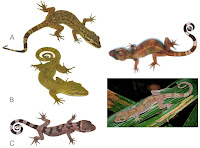 |
| Cyrtodactylus rukhadeva Grismer, Suwannapoom, Pawangkhanant, Nazarov, Yushchenko, Naiduangchan, Le, Luu & Poyarkov, 2021 ตุ๊กกายรุกขเทวา || DOI: 10.3897/vz.71.e76069 |
Abstract
The first integrative taxonomic analysis of the Cyrtodactylus brevipalmatus group of Southeast Asia recovered two newly discovered populations from the Tenasserim Mountains in Suan Phueng District, Ratchaburi Province, Thailand as a new species described here as Cyrtodactylus rukhadeva sp. nov. Based on 1397 base pairs of the mitochondrial gene NADH dehydrogenase subunit 2 (ND2), C. rukhadeva sp. nov. is the well-supported sister species to a clade containing three undescribed species, C. ngati, and C. cf. interdigitalis with a large uncorrected pairwise sequence divergence from other species in the brevipalmatus group ranging from 15.4–22.1%. Cyrtodactylus elok and C. brevipalmatus are recovered as poorly supported sister species and the well-supported sister lineage to the remainder of the brevipalmatus group. Cyrtodactylus rukhadeva sp. nov. is putatively diagnosable on the basis of a number of meristic characters and easily separated from the remaining species of the brevipalmatus group by a number of discrete morphological characters as well as its statistically significant wide separation in multivariate morphospace. The discovery of C. rukhadeva sp. nov. continues to underscore the unrealized herpetological diversity in the upland forests of the Tenasserim Mountains and that additional field work will undoubtedly result in the discovery of additional new species.
Key words: Bent-toed geckos, integrative taxonomy, Southeast Asia, Tenasserim Mountains
Cyrtodactylus rukhadeva sp. nov.
Suggested common name: Tree Spirit Bent-toed Gecko
Cyrtodactylus brevipalmatus Ulber 1993:198 (partim).
Diagnosis: Cyrtodactylus rukhadeva sp. nov. can be separated from all other species of the brevipalmatus group by having 9–11 supralabials, 10 or 11 infralabials, 27–30 paravertebral tubercles, 19 or 20 rows of longitudinally arranged tubercles, 34–43 transverse rows of ventrals, 152–154 longitudinal rows of ventrals, nine expanded subdigital lamellae on the fourth toe, 11 unexpanded subdigital lamellae on the fourth toe, 18–20 total subdigital lamellae on the fourth toe, eight or nine expanded subdigital lamellae on the fourth finger, nine or 10 unexpanded subdigital lamellae on the fourth finger, 17–19 total subdigital lamellae on the fourth finger, 16–17 enlarged femorals, 20 femoral pores in the male; 17 precloacal pores in the male; 13–17 enlarged precloacals; 16 post-precloacals; enlarged femorals and enlarged precloacals not continuous; proximal femorals not less than one-half the size of the distal femorals; small tubercles on forelimbs and flanks; small dorsolateral caudal tubercles and ventrolateral caudal fringe; paired enlarged subcaudals; and maximum SVL 79.4 mm (Tables 1, 4).
 |
| Bayesian phylogeny of the Cyrtodactylus brevipalmatus group based on 1397 base pairs of ND2 with BBP and UFB nodal support values, respectively at the nodes. |
Distribution: Cyrtodactylus rukhadeva sp. nov. is known only from the type locality from Khao Laem Mountain, Suan Phueng District, Ratchaburi Province, Thailand and Hoop Phai, Suan Phueng District, Ratchaburi Province, approximately 7.7 km to the west of the type locality (Fig. 1).
Etymology: The specific epithet “rukhadeva” is given as a noun in apposition and refers to the spirits or gods residing in trees in Thai mythology, known as Rukha Deva - รุกขเทพ (literally “Tree Nymphs”). According to Thai folklore, these sylvan spirits live on tree branches and on large older trees wearing traditional Thai attire, usually in reddish or brownish colours, and are believed to protect the forest. The new arboreal species of Cyrtodactylus resides in one of the remaining fragments of the north Tenasserim montane forests. We want to underscore the need for the immediate assessment of herpetofaunal diversity surveys and implementation of adequate conservation measures for these relic forests.
L. Lee Grismer, Chatmongkon Suwannapoom, Parinya Pawangkhanant, Roman A. Nazarov, Platon V. Yushchenko, Mali Naiduangchan, Minh Duc Le, Vinh Quang Luu and Nikolay A. Poyarkov. 2021. A New Cryptic Arboreal Species of the Cyrtodactylus brevipalmatus Group (Squamata: Gekkonidae) from the Uplands of western Thailand. Vertebrate Zoology. 71: 723-746. DOI: 10.3897/vz.71.e76069











